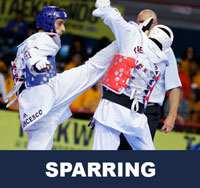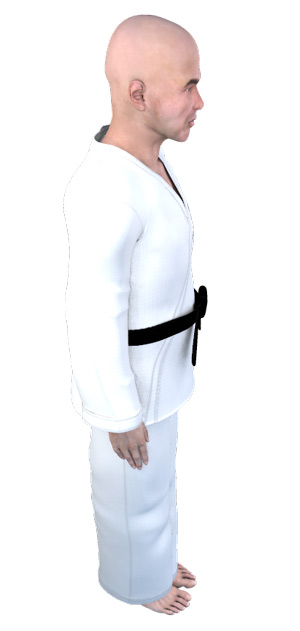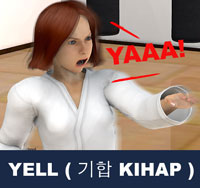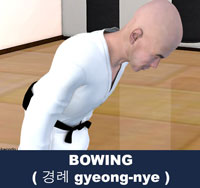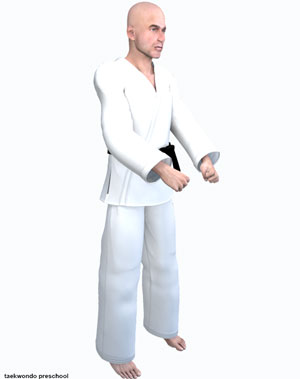Taekwondo 태권도Taekwondo Preschool
Taekwondo is known for its emphasis on high kicking and fast hand techniques, which distinguishes it from other popular martial arts and combat sports such as karate. However, the World Taekwondo (WT) believes that because the leg is the longest and strongest limb a martial artist has, kicks thus have the greatest potential to execute powerful strikes without successful retaliation.
View Taekwondo 태권도 »
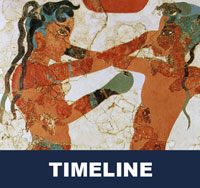
Martial Arts Timeline
The history of martial arts is challenging to document precisely, because of the lack of historical records, secretive nature of the teacher-student relationships and political circumstances during much of its history. It is likely that many techniques were learned, forgotten, and re-learned during human history.
History of Martial Arts
- Bronze Age (2000 to 1000 BCE)
- Iron Age (1000 BCE to CE 500)
- Middle Ages (500 to 1500)
- Early Modern Period (1500 to 1800)
- 19th Century
- 20th Century
This martial arts timeline is designed to help describe the history of the martial arts in a linear fashion. Many of the articles for particular styles have discussions of their history. This article is designed to help visualize the development of these arts, to help better understand the progression of the separate styles and illustrate where they interrelate.
The history of martial arts is challenging to document precisely, because of the lack of historical records, secretive nature of the teacher-student relationships and political circumstances during much of its history. It is likely that many techniques were learned, forgotten, and re-learned during human history.
Bronze Age (2000 to 1000 BCE)
- c.20th century BCE – Murals in tomb 15 at Beni Hasan, depicting wrestling techniques.
- c.18th century BCE – the Babylonian Gilgamesh epic includes the major hand-held weapons (sword, axe, bow and spear) used prior to the gunpowder era.
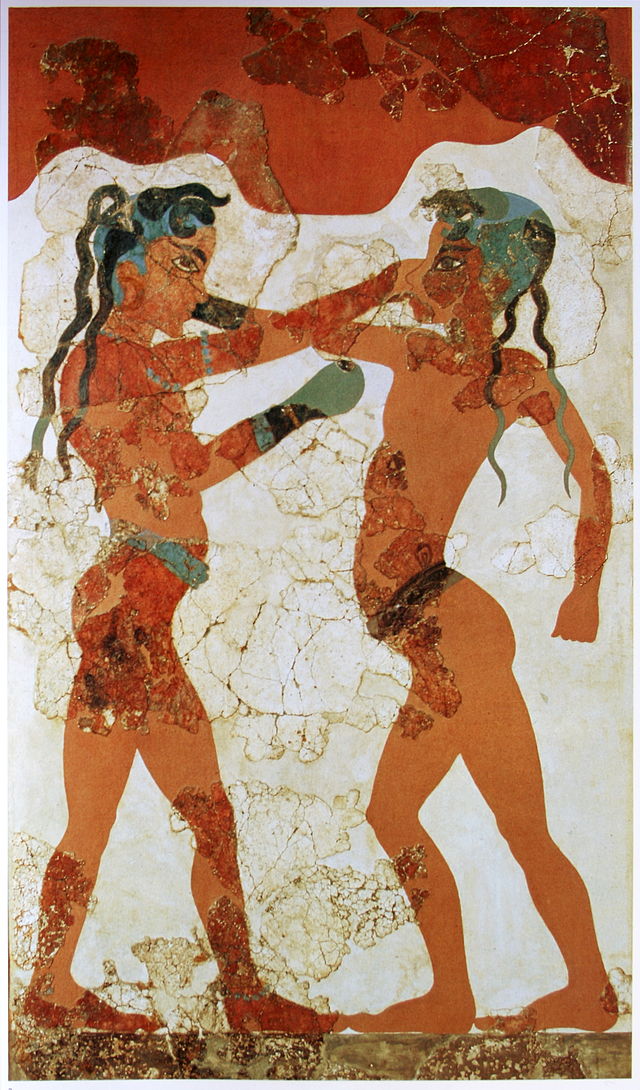
Iron Age and Antiquity (1000 BCE to CE 500)
- 8th century BCE – Roughly the start of Greek Olympic Competition. Through the popularity of the Olympics, martial arts like boxing, wrestling, and pankration flourished.
- 8th century BCE – Homer's Iliad describes many scenes of hand-to-hand combat in detail.
- 6th century BCE – Ten styles of Śastravidyā said to have been created around north India and combined in Takshashila, present-day Pakistan.
- c.4th century BCE – Indian epic poetry and the Vedas give the earliest written mention of South Asian martial arts. Boxing, wrestling, swordsmanship, archery, and the use of numerous weapons are all described in detail.
- 264 BCE – First recorded gladiatorial combat staged in Rome during the funeral of Junius Brutus.
- 50 BCE – Earliest records of a Korean martial art, namely taekkyon, found in paintings in the Muyong-chong, a royal tomb from the Goguryeo dynasty.
- CE 72 – The Colosseum opens in Rome, providing the public with the world's largest martial arts venue for over the next three hundred years.
- CE 1st century – Buddhist texts such as the Lotus Sutra mention a number of South Asian fighting arts, while the Khandhaka discourages their practice. Vajra-musti is also first attested to.
- CE 2nd century – P.Oxy. III 466, a Greek papyrus manuscript on wrestling, is written. It is the earliest known European martial arts manual.
- CE 477 - The first abbot of Shaolin Monastery was Buddhabadra, an Indian Dhyana master who came to China in AD 464 to translate Buddhist texts to Chinese. The Shaolin Temple is built at the western base of the Chinese Songshan mountain range, at the orders of Emperor Xiaowen. Successive Chinese emperors authorize fighting monks to train in the temple.
Middle Ages (500 to 1500)
- 7th century – The spread of Islam becomes a unifying force in the Middle East, bringing Arab and Persian weapons and armour to North Africa and neighbouring parts of Europe.
- c.700 – Kuvalaymala describes non-keshatriya students learning martial arts from Hindu priests at gurukula or traditional educational institutions.
- 728 – Date of the "combat stele" at the Shaolin Monastery
- 782 – Japanese Heian period begins. Curved swords called tachi (large sword) appear. Although samurai did not technically appear until the 12th century, in appearance these are the early curved swords commonly recognized as "samurai swords."
- c.800-900 – Agni Purana, the earliest known manual of dhanurveda, lists over 130 weapons, describes dozens of fighting stances, names techniques for various weapons, and provides a detailed discussion on archery.
- 1124–1138 – Manasollasa, written by King Someswara, gives the names of Indian wrestling techniques, training exercises and diet.
- 1156–1185 – Japanese samurai class emerges during the warring period between the Taira and Minamoto families. The warrior code of bushido also emerges during this time.
- 12th-13th century – Bas-reliefs in Angkor depict armed and unarmed combat.
- c. 1200 – Malla Purana, the oldest known text describing the techniques of malla-yuddha.
- c. 1300 – MS I.33, the oldest extant martial arts manual detailing armed combat.
- 1338 – Japanese Ashikaga era, during which the samurai class expands its influence further. Many schools of swordsmanship flourish. The period ends around 1500.
- 1400 – China sends delegations to Okinawa, which then begins trading extensively with China and Japan. The indigenous Okinawan unarmed combat art called tior te (hand) is likely influenced by Chinese and Japanese arts over the next three centuries, forming the basis for modern karate.
- 1477 – The Okinawan king Sho Shin, influenced by the Japanese, bans the carrying of arms. Similar bans occurred in Japan in 1586. Both apparently led to the underground development of striking arts and may have encouraged unarmed combat techniques designed for use against armored soldiers, such as jujutsu.

Early Modern Period (1500 to 1800)
- c. 1500 – Firearms become increasingly prevalent in Europe, diminishing the importance of traditional armed fighting systems.
- 1521 – Spanish conquistadors arrive in the Philippines, recording that the native population fought them off with broadswords and bamboo spears.
- 1527 – Mughals invade India, bringing Middle Eastern weaponry to South Asia and indirectly to the Malay Arcipelago. Indigenous malla-yuddha is supplanted by the Persian-derived pehlwani.
- 16th-19th centuries – Most of South and Southeast Asia gradually comes under European colonial rule. Martial practices are discouraged, in some places banned outright and preserved in secret.
- 1549 – Hayashizaki Minamoto is born and later founds the art of iajutsu or iaido, the art of drawing and cutting with the sword in a single motion. Successive masters of his school can be traced to the present day.
- 1600 – A newer style samurai sword, called a katana or daito, is widely used. Afro-Brazilian slaves begin to develop the art of capoeira.
- 1643 – Legendary Japanese swordsman Miyamoto Musashi is believed to have written The Book of Five Rings, a seminal work regarding the art and philosophy of the samurai and swordsmanship.
- 1674 – Maratha Empire founded by the warrior Shivaji, bringing his native art of mardani khel to prominence.
- 1699 – Faced with growing intolerance from the Mughal rulers, Guru Gobind Singh militarizes the Sikh community in order to defend their faith and independence. Sikhs and Panjabis in general subsequently become renowned as a warrior community.
- 1700s – Chinese temple frescoes depict Shaolin monks practicing unarmed combat. Okinawan te and Chinese Shaolin boxing styles mix as part of trade between the countries. Wing Chun is also founded in Yunnan.
- 1743 – Jack Broughton, an English bare-knuckle fighter, writes the first rules of boxing, later to become the London Prize Ring rules in 1838.
- 1750 – Techniques of taijiquan are written down.
- 1767 – Burmese capture Ayutthaya and burn the kingdom's archives, including manuals on boxing and swordsmanship.
- 1790 – Muyedobotongji is commissioned by King Jeongjo of Korea and written by Yi Deokmu, Pak Jega, and Baek Dongsu. 24 techniques are illustrated and described, of which one deals with unarmed combat, 21 deal with armed combat, and six include equestrian skills. Drawing from Korean, Chinese, and Japanese sources, it is one of the most comprehensive pre-modern military manuals of East Asia.
19th Century
- 1800-1900 – Brazilian police periodically arrest anyone caught practicing capoeira. In 1862 alone, 404 people are arrested for capoeira.
- 1825-1900 – Savate shifts from its street-fighting roots to a modern sport.
- 1867 – John Graham Chambers publishes a revised set of rules for boxing. They are publicly endorsed by John Douglas, 9th Marquess of Queensberry, leading the rules to become known as the "Marquess of Queensberry rules".
- 1882 – Jigoro Kano modifies traditional Japanese jujutsu to develop the art of judo. He opens his school, Kodokan. One of his training methods, called randori, removed more dangerous striking techniques to emphasize grappling and submission locks between students practising at full-force. His students taught judo using randori around the world during the early 20th century.
- 1892 - The first world heavyweight boxing championship is fought under the Marquess of Queensberry rules of 1867, which are similar to those used today. Jim Corbett defeats John L. Sullivan.
- 1890s – British introduction of western boxing to India results in a decline of native musti-yuddha until it survives only in Varanasi.
- 1893-1901 – Edward William Barton-Wright studies jujutsu in Japan and creates Bartitsu upon returning to England, one of the earliest introductions of Japanese martial arts in the West and the first known system to combine Asian and European fighting styles.
20th Century
- 1908 – Amateur boxing becomes an Olympic Sport.
- 1920-1925 – Mitsuyo Maeda, a student of Jigoro Kano's, travels to Brazil (among other places) to spread judo. In 1925, Carlos Gracie, a student of Mitsuyo Maeda, opens his school, the first for Brazilian Jiu-Jitsu. The art is further refined by the Gracie family thereafter, particularly by Carlos' brother Helio Gracie.
- 1928 – Shaolin temple records are burned, destroying many documents and records of earlier martial arts.
- 1920s-30s – Timed rounds, weight classes and standardized rules are introduced to Southeast Asian kickboxing under European influence. Modern gloves are made compulsory, replacing the hemp rope bindings, resulting in less grievous injuries and fewer deaths but also making many traditional techniques illegal. In Thailand, the newer ring-style becomes known as muay Thai (Thai boxing) while the older form is called muay boran (ancient boxing).
- 1930s – Imi Lichtenfeld begins developing Krav Maga in Czechoslovakia
- 1932 – Mestre Bimba opens the first capoeira school, calling the style Luta Regional Baiana ("regional fight from Bahia"), because capoeira was still illegal in name.
- 1935 – “Karate” becomes official name of the Okinawan martial arts, based on the traditional art of te (hand) and the term kara (empty or unarmed).
- 1936 – Gichin Funakoshi publishes the first edition of his book Karate-Do Kyohan, documenting much of the philosophy and traditional kata (forms) of modern karate. A second edition was published in 1973, many years after his death in 1957.
- 1938 – Sambo presented by Anatoly Kharlampiev; Nguyễn Lộc introduces Vovinam to the public.
- 1942 – Morihei Ueshiba begins using the term aikido to describe his art, which is related to aiki-jujutsu.
- 1943 – Judo, karate, and various Chinese systems are officially introduced in Korea, likely beginning to mix with the indigenous Korean arts.
- 1945 – First Korean dojang or martial arts school opens in Seoul, Korea. Many other schools follow. Korean military personnel receive training in martial arts.
- 1945 – Choi Yong-sool travels back to Korea after living in Japan with Sokaku Takeda. He begins teaching Dai Dong Yusool (daitō-ryū aiki-jūjutsu), later to become known as hapkido.
- 1945 – World War II ends, with many more American and British soldiers stationed in Asia exposed to the region's fighting systems. This includes the American Robert A. Trias who began teaching Asian-based martial arts in Phoenix, AZ.
- 1949–1950 - Yip Man leaves Foshan and moves to Hong Kong to escape the communist government and begins teaching Wing Chun to his first Hong Kong student Leung Sheung.
- 1955 – On April 11 General Choi calls a meeting between Korean masters to unify the Korean martial arts.
- 1957 – Nine Korean training halls unite under the name taekwondo (way of the foot and fist).
- 1959 – Bruce Lee arrives in America and begins to teach Wing Chun to his first student, African American Jesse Glover, the first documented instance of a westerner learning Chinese martial arts.
- 1964 – Kyokushin Kaikan, a style of stand-up full-contact karate, founded by Masutatsu Oyama.
- 1964 – Judo becomes an official Olympic sport.
- 1966 – International Taekwon-Do Federation (ITF) is formed on March 22, 1966.
- 1969 – Greek-American Jim Arvanitis introduces a modern reconstruction of pankration.
- 1973 – The Bruce Lee film Enter the Dragon brings Chinese martial arts to the United States domestic audience. He dies that same year.
- 1973 – Kukkiwon (국기원), also known as World Taekwondo Headquarters officially named on February 6, 1973.
- 1973 – World Taekwondo Federation (WTF) is formed in May 28, 1973.
- 1975 – Bruce Lee's book Tao of Jeet Kune Do is published post-mortem. He credits the influence of western boxing and fencing in developing his art, among others.
- 1985 - Satoru Sayama, forms Shooto, a shootwrestling organization. It would go on to become the first mixed martial arts organization in the world.
- 1988 – WTF-style taekwondo becomes an Olympic demonstration sport, later becoming a full-medal sport in 2000.
- 1993 – The first Ultimate Fighting Championship (UFC) is held. Brazilian Jiu-Jitsu practitioner Royce Gracie wins the event.
- 1992 – WTF-style taekwondo was again a demonstration sport at the 1992 Summer Olympics in Barcelona, Spain.
- 2000 – WTF-style taekwondo became a full medal sport at the 2000 Summer Olympics in Sydney, Australia.
- 2017 – World Taekwondo Federation (WTF) has renamed itself to World Taekwondo (WT).
Promotion from one dan to the next can take years. The general rule is that a black belt may advance from one rank to the next only after the number of years equivalent to the current rank. For example, a newly promoted third-degree black belt may not be allowed to advance to fourth-degree until three years have passed. For more information View Dan 단 ( Black Belt Degree) »
RESOURCES
This article uses material from the Wikipedia article "Martial Arts Timeline", which is released under the Creative Commons Attribution-Share-Alike License 3.0.



